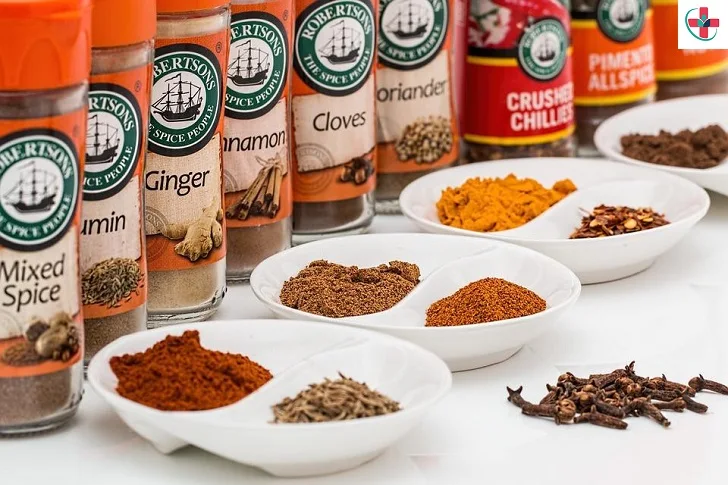Research about the therapeutic effects of herbs and spices
is enticing, but how does it translate to what you eat every day? Quite easily, as a matter of fact. It turns
out that relatively small amounts of dried and fresh herbs and spices may have
health benefits.
THE HEALTH BENEFITS OF HERBS AND SPICES
We’re big proponents of incorporating herbs and spices into foods for more than one reason. First, they make healthy foods taste better. Using herbs and spices is an easy way to add flavor when you’re cutting back on salt, for example. And, many people enjoy eating lean meats and vegetables more—even without added fat—when herbs and spices are used. This can help you reduce your calorie intake, and limit the amount of saturated fat (think butter) you use in your cooking.
As if the benefit of amazing taste wasn’t enough, the compounds in herbs and spices can have some powerful positive effects on your health as well—another reason why they play a starring role in the food.
Research into the specific ways herbs and spices can improve health has mushroomed in the past few years. We are still a ways from knowing just how to optimize these benefits, but we do feel confident encouraging you to spice things up to boost the potential of your home-cooked meals.
WHAT’S IN HERBS AND SPICES THAT MAKES THEM GOOD FOR YOU?
The compounds responsible for the aroma and flavor of herbs and spices are frequently the same ones that may help improve your health and prevent disease. Here’s how they function in the body:
- Antioxidant activity—Many of the compounds in herbs and spices fight oxidation and free radicals that can damage cell membranes, DNA and proteins. Oxidative damage and stress contribute to many diseases including cancer, cardiovascular diseases, and Alzheimer’s disease. Consistently leading the list when it comes to this benefit: cinnamon, cloves, oregano, peppermint, and thyme.
- Anti-inflammatory activity—Inflammation can be both noticeable, like the pain of arthritis or gastritis, or hidden, like the chronic inflammation, thought to be part of cardiovascular disease and Alzheimer’s disease. Many herbs and spices, like turmeric and cumin, are potent anti-inflammatory agents.
- Blood sugar control—Cinnamon, in particular, is being studied for its ability to keep blood sugar levels stable and enhance the effect of insulin in people who have insulin resistance or metabolic syndrome.
- Antimicrobial activity—Chiles, basil, cinnamon, coriander, cumin, garlic, and ginger are just a few of the spices that protect against harmful bacterial growth. They have traditionally been used to keep meat safe from bacteria in warm climates, and their role in maintaining healthy bacterial growth in the large intestine is being explored.
- Anti-cancer activity—Many herbs and spices contain compounds that help inhibit tumor growth, prevent cell mutation, and influence enzymes that aid the liver in clearing potentially toxic substances.
- And more!—There are likely many other beneficial compounds in herbs and spices. Take, for example, the finding that spicing up your food with red pepper may help you eat less. People who were given red pepper either on their food or in capsules ate about 25 percent less at their next meal compared with those who didn’t have the spice, according to a study in Nutrition Today. It also seemed to increase the number of calories they burned, suggesting that the active ingredient in red peppers, capsaicin, has a direct effect on metabolism.
Tips on how to incorporate more herbs and spices into your favorite foods.
Herbs and Spices: A Little Goes a Long Way
You don’t need to make drastic changes in your eating plan
to benefit from seasonings. Here’s how to incorporate more herbs and spices
into your favorite foods.
- Ground cinnamon: Add 1.25 teaspoons to prepared oatmeal; 1 cup Greek yogurt mixed with 2 teaspoons molasses or honey, or artificial sweetener; and French toast batter. Sprinkle half a teaspoon of cinnamon over ground coffee before brewing. Top a fat-free latte or hot cocoa with ground cinnamon.
- Chili peppers: Add chopped peppers to chili, burgers, soups, stews, salsa, and egg dishes.
- Turmeric: Sprinkle on egg salad. Mix half a teaspoon turmeric with 1 cup of Greek yogurt and use it as a dip or sandwich spread. Add to chicken or seafood casseroles, and to water when cooking rice.
- Garlic: Add fresh chopped or minced garlic to pasta dishes, stir-fry dishes, pizza, fresh tomato sauce, and meat and poultry recipes.
- Oregano: Add 1/8 teaspoon dried to scrambled eggs, salad dressings, and store-bought or homemade marinara sauce. Sprinkle some on top of pizza, and stir into black beans soup.
- Basil: Make a sandwich with low-fat mozzarella cheese, sliced tomatoes, and fresh basil leaves; add fresh leaves to green salads.
- Thyme: Sprinkle dried thyme onto cooked vegetables in place of butter or margarine. Add 1/8 teaspoon dried thyme to two scrambled eggs, and to salad dressings. Use it in a rub when cooking salmon. Add fresh thyme to chicken salad and chicken soup.
- Rosemary: Add dried crushed rosemary to mashed potatoes and vegetable omelets.
- Parsley: Add chopped flat-leaf parsley to meatballs and meatloaf, and to bulgur salad.
- Ginger: Grate fresh ginger into quick bread batters and vinaigrette. Add chopped ginger to stir-fries. Sprinkle ground ginger on cooked carrots.
- Cloves: Sprinkle ground cloves on applesauce, add to quick bread batters, and add a pinch to hot tea.
